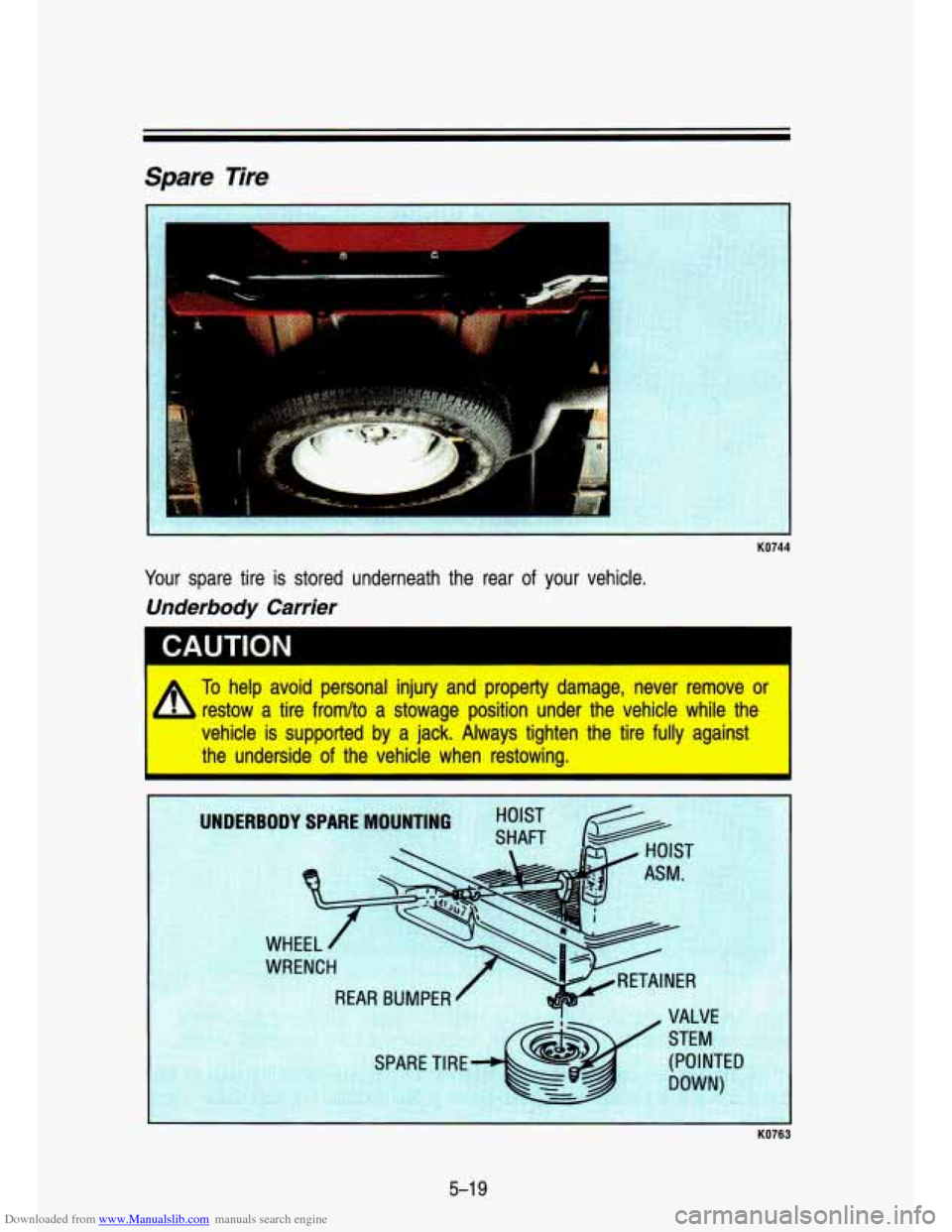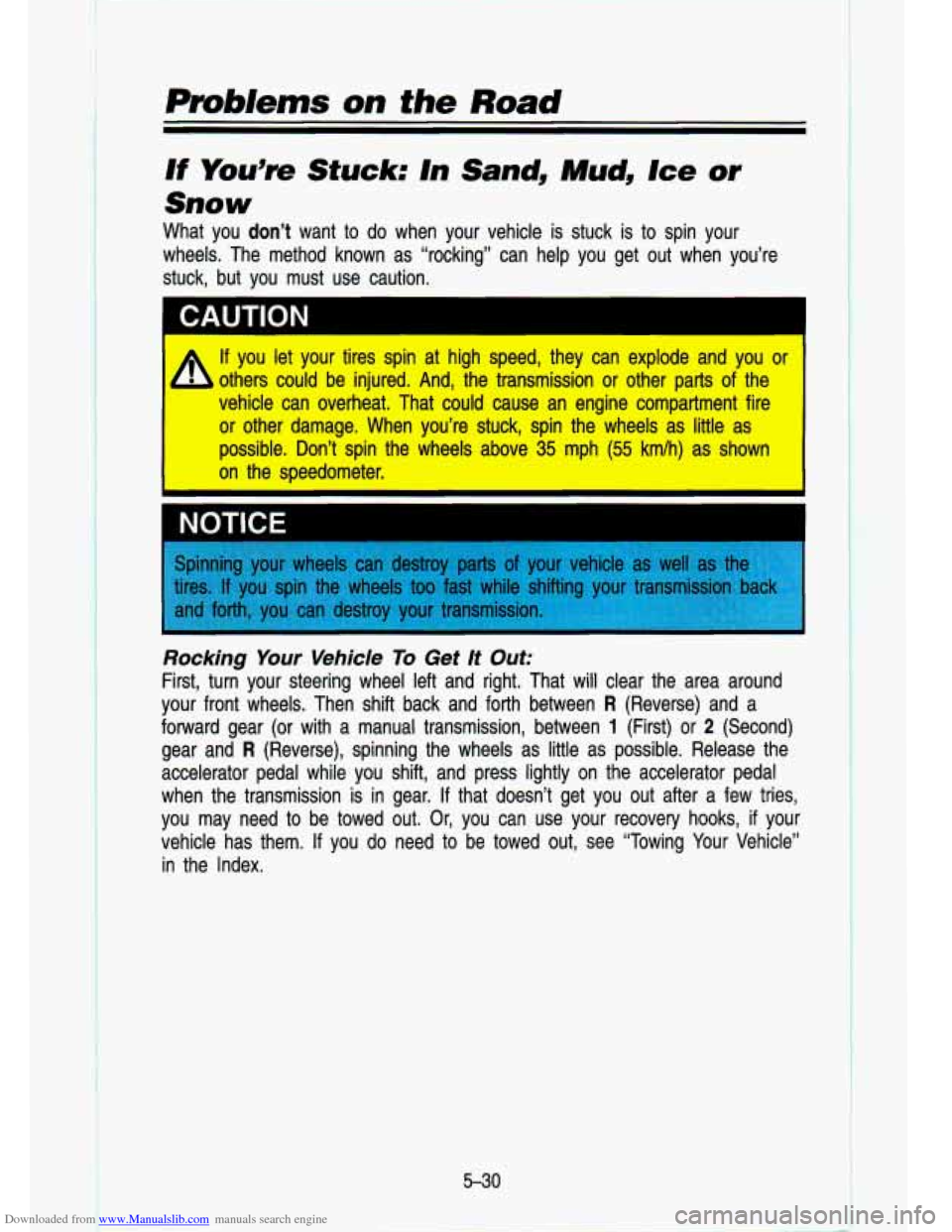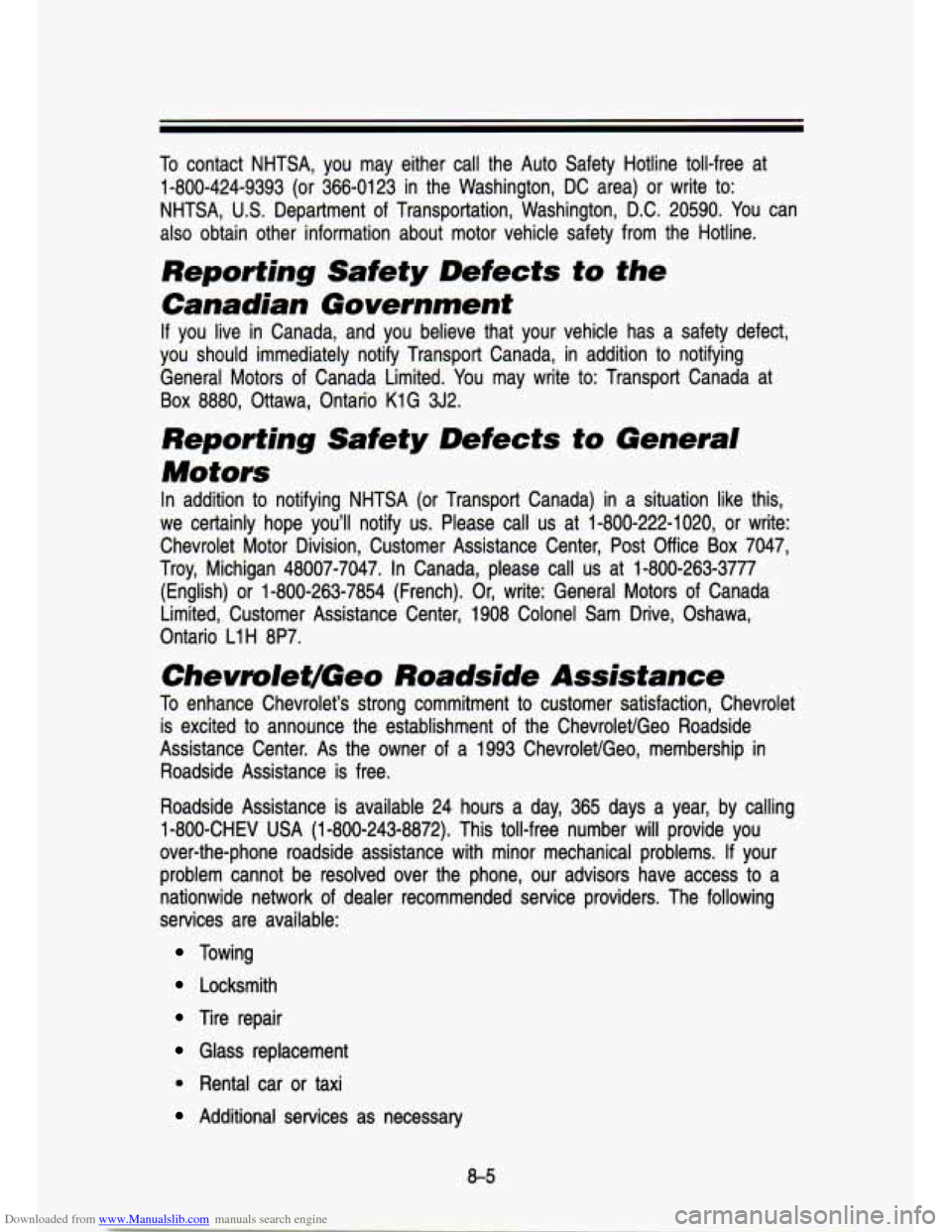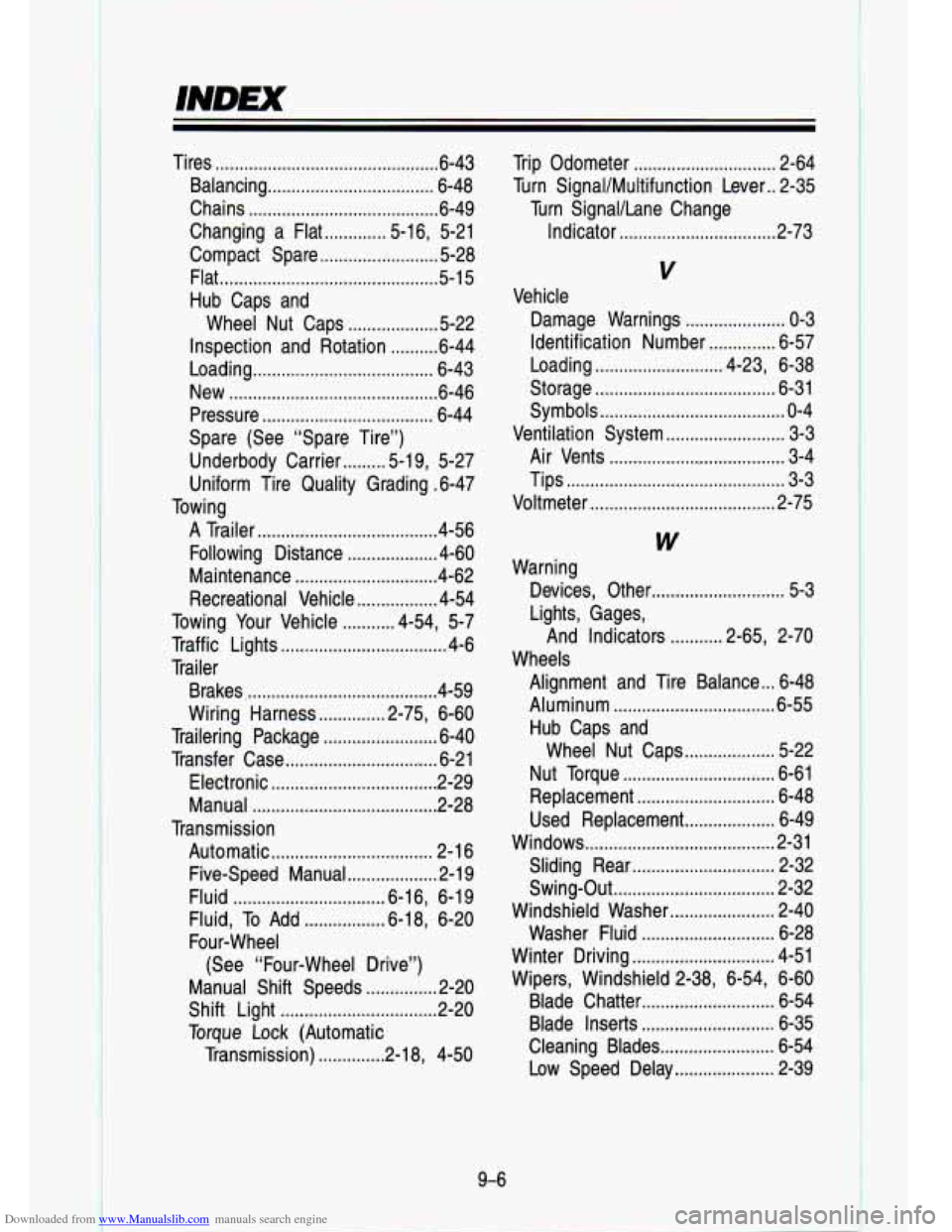1993 CHEVROLET S10 towing
[x] Cancel search: towingPage 224 of 356

Downloaded from www.Manualslib.com manuals search engine , vr
KO51 9
When your vehicle is being towed, have the ignition key off. The steering
wheel should be clamped in a straight-ahead position with a clamping device
designed for a towing service. Do not use the vehicle's steeri\
ng column
lock for this. The transmission (either automatic or manual) should\
be in
N (Neutral) and the transfer case (either manual shift or elec\
tronic shift), if
you have one, should be in 2 WHEEL (two-wheel drive). The parking brake
should be released.
Don't have your vehicle towed on the rear (drive) wheels, un\
less you have
to,
If the vehicle must be towed on the rear wheels, don't go more than 35 mph
(56 km/h) or farther than 50 miles (80 km) or your transmission will be
damaged.
If these limits must be exceeded, then the rear drive wheels have\
to be supported on a dolly.
If your vehicle has the four-wheel-drive option, a dolly
MUST be used under
the rear wheels when towing from the front.
5-8
Page 231 of 356

Downloaded from www.Manualslib.com manuals search engine KO721
8. Then replace the pressure cap. Be sure the arrows on the pres\
sure cap line up like this.
Engine Fan Noise
This vehicle has a clutched engine cooling fan. When the clutch is engaged,
the fan spins faster to provide more air to cool the engine. In most every day
driving conditions the clutch is not engaged. This improves fue\
l economy and
reduces fan noise. Under heavy vehicle loading, trailer towing andlor high
outside temperatures, the fan speed increases when the clutch e\
ngages.
So
you may hear an increase in fan noise. This is normal and should not be
mistaken as the transmission slipping or making extra shifts.
It is merely the
cooling system functioning properly. The fan will slow down whe\
n additional
cooling is not required and the clutch disengages.
You may also hear this fan noise when you start the engine. It will go away
as the fan clutch disengages.
If a Tire Goes Flat
It’s unusual for a tire to “blowout” while you’re d\
riving, especially if you
maintain your tires properly.
If air goes out of a tire, it’s much more likely to
leak out slowly. But if you should ever have a “blowout,”\
here are a few tips
about what to expect and what to do:
If a front tire fails, the flat tire will create a drag that pu\
lls the vehicle toward
that side. Take your foot off the accelerator pedal and grip the steering wheel
firmly. Steer to maintain lane position, then gently brake to \
a stop well out of
the traffic lane.
5-1 5
Page 235 of 356

Downloaded from www.Manualslib.com manuals search engine Spare Tire
1
KO744
Your spare tire is stored underneath the rear of your vehicle.
Underbody Carrier
To help avoid personal injury and property damage, never remove or
restow a tire fromlto a stowage position under the vehicle while the
vehicle is supported
by a jack. Always tighten the tire fully against
the underside
of the vehicle when restowing. I
KOi - '63
5-1 9
Page 246 of 356

Downloaded from www.Manualslib.com manuals search engine Pm6/ems on the Road
If You’re Stuck: In Sand, Mud, Ice or
snow
What you don’t want to do when your vehicle is stuck is to spin your
wheels. The method known as “rocking” can help you get o\
ut when you’re
stuck, but you must use caution.
~
fi If you let your tires spin at high speed, they can explode and you1 or
others could be injured. And, the transmiss’ion or other parts of the
vehicle
can overheat. That could cause an engine comparlme’nt fire
or other damage. When you’re
stuck, spin the wheels as little as
possible.
Don’t spin the wheels above 35 rnph 1(55 krn/h) as shown
oln the speedometer.
Rocking Your Vehicle To Get It Out:
First, turn your steering wheel left and right. That will clear the area \
around
your front wheels. Then shift back and forth between
R (Reverse) and a
forward gear (or with a manual transmission, between
1 (First) or 2 (Second)
gear and
R (Reverse), spinning the wheels as little as possible. Release \
the
accelerator pedal while you shift, and press lightly on the accelerator pedal
when the transmission is in gear.
If that doesn’t get you out after a few tries,
you may need to be towed
out. Or, you can use your recovery hooks, if your
vehicle has them.
If you do need to be towed out, see “Towing Your Vehicle’’
in the Index.
5-30
Page 326 of 356

Downloaded from www.Manualslib.com manuals search engine Scheduled Maintenance Services
13. ENGINE ACCESSORY DRIVE BELT INSPECTION*-Inspect belt. Look
for cracks, fraying, wear, and proper tension. Adjust or replac\
e as needed.
14. TIRE AND WHEEL ROTATION AND INSPECTION -For proper wear and maximum tire life, rotate tires at the first
6,000 miles (10 000
kilometers) for Schedule I or 7,500 miles (12 500 kilometers) for
Schedule
II and then every 15,000 miles (25 000 kilometers) thereafter.
Follow the instructions and patterns shown in Section
6. Check tires for
uneven wear or damage.
If irregular or premature wear is apparent,
check wheel alignment. Also, check for damaged wheels. See “\
Tires” in
the Index for more information.
15. DRIVE AXLE SERVICE -Check rear/front axle fluid level and add \
as
needed. Check constant velocity joints and axle seals for leaki\
ng.
Locking differential -Drain fluid at first oil change and refill. Check
fluid level and add as needed at subsequent oil changes. In d\
usty areas
or trailer towing applications, drain fluid at every 15,000 miles
(24
135 kilometers) and refi1l.t
Standard differential -Check fluid level and add as needed at
every oil change. In dusty areas or trailer towing applications\
, drain
fluid every
15,000 miles (24 135 kilometers) and refil1.t
More frequent lubrication may be required for off-road use.
16. BRAKE SYSTEM INSPECTION -When the engine oil is changed,
inspect the lines and hoses for proper hookup, binding, leaks, \
cracks,
chafing, etc. Check the parking brake adjustment, and the fluid\
level in
the master cylinder. A low fluid level can indicate worn disc \
brake pads
which may need to be serviced.t
When the wheels are removed for rotation, inspect disc brake p\
ads for
wear and rotors for surface condition. Also inspect drum brake \
linings for
wear and cracks. Inspect other brake parts, including drums, wh\
eel cylinders, parking brake, etc., at the same time.
Inspect brakes more often if driving habits or conditions resul\
t
in
frequent braking.
tA fluid
loss in these systems may indicate a problem. Have them inspected
and repaired at once.
7-1 0
Page 339 of 356

Downloaded from www.Manualslib.com manuals search engine To contact NHTSA, you may either call the Auto Safety Hotline tol\
l-free at
1-800-424-9393 (or 366-0123 in the Washington,
DC area) or write to:
NHTSA,
US. Department of Transportation, Washington, D.C. 20590. You can
also obtain other information about motor vehicle safety from t\
he Hotline.
Reporting Safety Defects to the
Canadian Government
If you live in Canada, and you believe that your vehicle has a \
safety defect,
you should immediately notify Transport Canada, in addition to notifying
General Motors of Canada Limited. You may write to: Transport Canada at
Box 8880, Ottawa, Ontario K1G 3J2.
Reporting Safety Defects to General
Motors
In addition to notifying NHTSA (or Transport Canada) in a situation like this,
we certainly hope you’ll notify
us. Please call us at 1-800-222-1020, or write:
Chevrolet Motor Division, Customer Assistance Center, Post Office\
Box 7047,
Troy, Michigan 48007-7047. In Canada, please call us at 1-800-263-3777
(English) or 1-800-263-7854 (French). Or, write: General Motors
of Canada
Limited, Customer Assistance Center, 1908 Colonel Sam Drive, Osh\
awa,
Ontario L1H 8P7.
Chevrolet/Geo Roadside Assistance
To enhance Chevrolet’s strong commitment to customer satisfaction,\
Chevrolet
is excited to announce the establishment of the ChevroletlGeo Roadside
Assistance Center.
As the owner of a 1993 ChevroletlGeo, membership in
Roadside Assistance is free.
Roadside Assistance is available 24 hours a day, 365 days a year, by calling
1-800-CHEV USA (1-800-243-8872). This toll-free number will pro\
vide you
over-the-phone roadside assistance with minor mechanical problems.\
If your
problem cannot be resolved over the phone, our advisors have a\
ccess to a
nationwide network of dealer recommended service providers. The following
services are available:
Towing
Locksmith
Tire repair
Glass replacement
* Rental car or taxi
Additional services as necessary
8-5
Page 352 of 356

Downloaded from www.Manualslib.com manuals search engine ... .. .- i’. .. - . .
Tires ............................................... 6.43
Balancing
................................... 6-48
Chains
........................................ 6-49
Changing a Flat
............. 5.16, 5-21
Compact Spare
......................... 5-28
Flat
.............................................. 5-1 5
Hub Caps and Wheel Nut Caps
................... 5-22
Inspection and Rotation
.......... 6-44
Loading
...................................... 6-43
New
............................................ 6-46
Pressure
..................................... 6-44
Spare (See “Spare Tire”)
Uniform Tire Quality Grading
. 6-47
A Trailer
...................................... 4-56
Following Distance
................... 4-60
Maintenance
.............................. 4-62
Recreational Vehicle
................. 4-54
Towing Your Vehicle
........... 4-54, 5-7
Traffic Lights
................................... 4-6
Trailer
Brakes
......................................... 4-59
Wiring Harness
.............. 2-75, 6-60
Trailering Package
........................ 6-40
Transfer Case
................................. 6-21
Electronic
................................... 2-29
Manual
....................................... 2-28
Automatic
.................................. 2-1 6
Five-Speed Manual
................... 2-1 9
Fluid
................................ 6-1 6, 6-1 9
Fluid, To Add
................. 6-18, 6-20
Four-wheel
Manual Shift Speeds
............... 2-20
Shift Light
................................. 2-20
Torque Lock (Automatic
Transmission)
.............. 2-1 8, 4-50
Underbody
Carrier
......... 5-1 9, 5-27
Towing
Transmission (See “Four-wheel Drive”) Trip
Odometer
.............................. 2-64
Turn Signal/Multifunction Lever
.. 2-35
Indicator
................................. 2.73
Turn SignaVLane Change
V
Vehicle
Damage Warnings
..................... 0-3
Identification Number
.............. 6-57
Loading
........................... 4.23. 6-38
Storage
...................................... 6-31
Symbols
....................................... 0-4
Ventilation System
......................... 3-3
Air Vents
...................................... 3-4
Tips
.............................................. 3-3
Voltmeter ....................................... 2-75
I
W
Devices. Other ............................ 5-3
Lights. Gages. And Indicators
........... 2.65. 2-70
Alignment and Tire Balance
... 6-48
Aluminum
.................................. 6-55
Hub Caps and Wheel Nut Caps
................... 5-22
Nut Torque
................................ 6-61
Replacement
............................. 6-48
Used Replacement
................... 6-49
Windows
........................................ 2-31
Sliding Rear
.............................. 2-32
Swing-Out
.................................. 2-32
Windshield Washer
...................... 2-40
Washer Fluid
............................ 6-28
Winter Driving
.............................. 4-51
Wipers. Windshield 2.38. 6.54. 6-60
Blade Chatter
............................ 6-54
Blade Inserts
....... .................... 6-35
Cleaning Blades
........................ 6-54
Low Speed Delay
..................... 2-39
Warning
Wheels
9-6